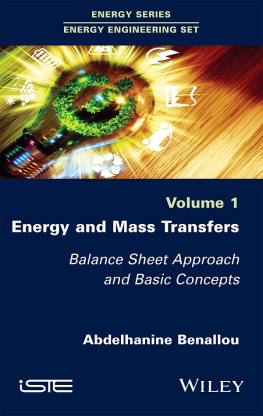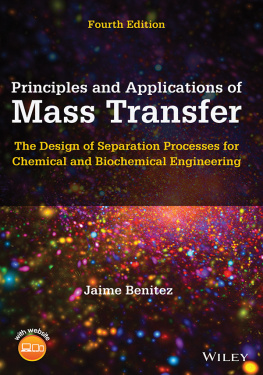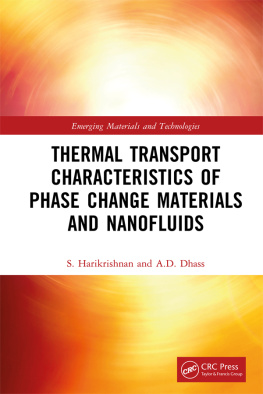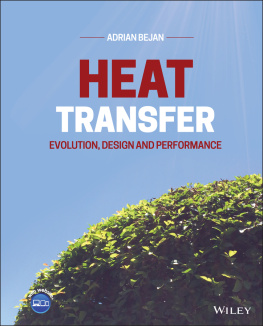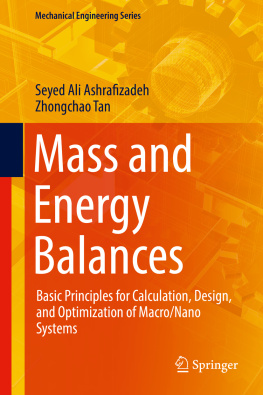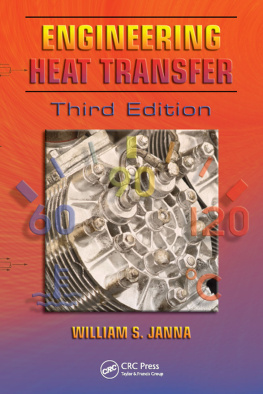
Energy Engineering Set
coordinated by Abdelhanine Benallou
Volume 1
Energy and Mass Transfers
Balance Sheet Approach and Basic Concepts
Abdelhanine Benallou
First published 2018 in Great Britain and the United States by ISTE Ltd and John Wiley & Sons, Inc.
Apart from any fair dealing for the purposes of research or private study, or criticism or review, as permitted under the Copyright, Designs and Patents Act 1988, this publication may only be reproduced, stored or transmitted, in any form or by any means, with the prior permission in writing of the publishers, or in the case of reprographic reproduction in accordance with the terms and licenses issued by the CLA. Enquiries concerning reproduction outside these terms should be sent to the publishers at the undermentioned address:
ISTE Ltd
27-37 St Georges Road
London SW19 4EU
UK
www.iste.co.uk
John Wiley & Sons, Inc.
111 River Street
Hoboken, NJ 07030
USA
www.wiley.com
ISTE Ltd 2018
The rights of Abdelhanine Benallou to be identified as the author of this work have been asserted by him in accordance with the Copyright, Designs and Patents Act 1988.
Library of Congress Control Number: 2018938268
British Library Cataloguing-in-Publication Data
A CIP record for this book is available from the British Library
ISBN 978-1-78630-274-8
Preface
Good things arising from prosperity are desired, but good things stemming from adversity are admired
Seneca, stoic philosopher, 4 BC. - 65 AD.
For several years, I have cherished the wish of devoting enough time to the writing of a series of books on energy engineering. The reason is simple: for having practiced for years teaching as well as consulting in different areas ranging from energy planning to rational use of energy and renewable energies, I have always noted the lack of formal documentation in these fields to constitute a complete and coherent source of reference, both as a tool for teaching to be used by engineering professors and as a source of information summarizing, for engineering students and practicing engineers, the basic principles and the founding mechanisms of energy and mass transfers leading to calculation methods and design techniques.
But between the teaching and research tasks (first as a teaching assistant at the University of California and later as a professor at the cole des mines de Rabat, Morocco) and the consulting and management endeavors conducted in the private and in the public sectors, this wish remained for more than twenty years in my long list of priorities, without having the possibility to make its way up to the top. Only providence was able to unleash the constraints and provide enough time to achieve a lifetime objective.
This led to a series consisting of nine volumes:
- Volume 1: Energy and Mass Transfers;
- Volume 2: Energy Transfers by Conduction;
- Volume 3: Energy Transfers by Convection;
- Volume 4: Energy Transfers by Radiation;
- Volume 5: Mass Transfers and Physical Data Estimation;
- Volume 6: Design and Calculation of Heat Exchanges;
- Volume 7: Solar Thermal Engineering;
- Volume 8: Solar Photovoltaic Energy Engineering;
- Volume 9: Rational Energy Use Engineering.
The present book is the first volume of this series. It groups the basic concepts and the fundamental mechanisms governing heat and mass transfers. It aims to meet the requirements of clarity in the presentation of the fundamental theories in the perspective of enabling students to fully understand the basic principles, before moving on to the details of equipment design and sizing.
This book is therefore introductory and simple. It is intended to expose the mechanisms governing heat and matter transfers within the same system or between two or more systems.
As we will see throughout this book, applications of these concepts and principles are multiple: they are considered essential in sizing techniques of industrial equipment of different kinds. They also have become paramount in the design of smart buildings and in the development of mathematical models to perform predictions of climate change through the greenhouse effect or the thinning of the ozone layer. In addition, these concepts form the basis of engineering calculation methods of industrial equipment, which must satisfy, from now on, minimum energy consumption constraints.
This introductory book constitutes a clear and solid foundation, on which a robust construction of energy engineering techniques can be undertaken.
We have consequently used simple and practical ways to explain complicated principles. We have also given considerable importance throughout the document to integrating as many practical examples as illustrations, to allow a better visualization of the phenomena and to help make applications of the different equations, student friendly, positive, tangible and concrete.
Abdelhanine BENALLOU
April 2018
Introduction
Transfer Techniques: What Role for the Engineer?
I.1. Energy and mass transfers in industry
Within different industries, products are often elaborated through the transformation of several inputs. In most cases, various manipulations of the inputs are involved before arriving at the desired end products. Through these manipulations, the initial inputs undergo multiple transformations during which they are heated, cooled or even consumed in order to give rise to new components.
It is obvious that heating or cooling will require energy exchange between the components of the process considered. In the same way, generation of new products implies chemical reactions between the inputs.
Thus, during the course of these transformations, several types of transfer take place between the inputs. Energy and mass transfers are the most significant. Whilst mass transfers are mainly conducted to purify or to elaborate products, energy transfers are intended to provide the calories necessary for heating, as well as cooling or air conditioning, delivering the heat for an endothermic chemical reaction, or cooling a nuclear reactor, etc.
I.2. Practical examples
I.2.1.Oil extraction and refining
We already know that in order to manufacture the different fuels that we use for our convenience (gasoline or kerosene, for example), we first have to proceed with the extraction of oil, onshore or offshore.
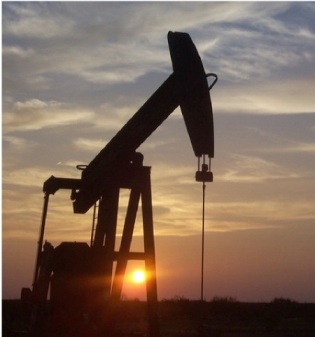
Figure I.1.Onshore crude oil extraction (https://pixabay.com/fr/grer-texas-591934/)

Figure I.2.Offshore crude oil extraction (https://cdn.pixabay.com/photo/2017/04/22/16/06/rig-2251648_960_720.jpg)
The crude oil produced in this way is then transferred to refineries, where it will be treated to extract various fuels.
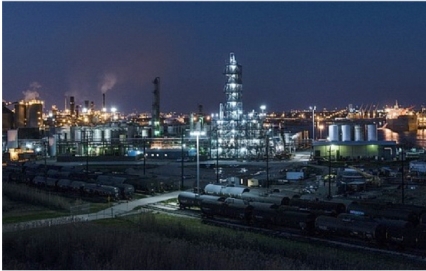 Next page
Next page
